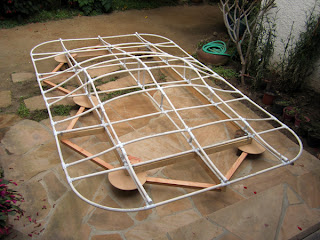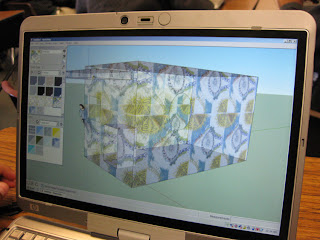The stickers in this model (he used translucent Zip-A-Tone...remember that medium!) represent vinyl window decals that the public will stick to the polygal walls. I will be taking youth pattern reflections on local community and will be translating them into vector files (Illustrator) so that I can laser cut colored vinyl film, hopefully at the TechShop, to create the decals.
How will people interact with this installation?
- They will add vinyl decals (of various sizes and colors) to the walls to create a colorful collaborative collage. At night the shelter will light up like stained glass. (day and evening activity) This idea is inspired by the Obliteration Room by Yayoi Kusama.
- Using a wii remote interactive surface set up, the public will explore creating a large mural of patterns created from local photos. This will be on one wall of the shelter. (evening activity)
- Using Makedo connectors, the public will add components of polygal and cardboard to grow the space and to add their ideas of what other features it could have. (day and evening activity) We will be adding pre-drilled holes to the polygal to facilitate the connection of Makedo parts.
Table activity of small scale model making:
At the 2012 ZERO1 Biennial, there will also be tables set up at which the public can create small scale models of innovative bus shelters they envision. I just posted info in this lesson plan at Instructables. 5th graders I taught this school year will be assisting in teaching this workshop at the festival. We will have a diorama in which to photograph the festival creations and upload them to a flickr set for sharing with the schools participating in the Seeking Shelter Design Challenge.

























